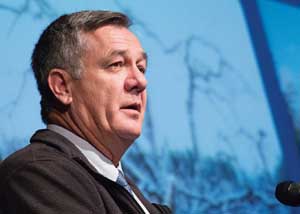
Terence Robinson
Honeycrisp apples are precocious and profuse bloomers, and with the value of their fruit being so high, every apple on a young tree is like a 50-cent piece hanging there.
Growers must resist the temptation to harvest too many of those coins too early.
“You need to grow the tree first,” says Cornell University horticulturist Dr. Terence Robinson. “Honeycrisp sets more flowers than most cultivars and needs to be managed right, right from the start. We need to take off most of those early fruits. Honeycrisp has only half the shoot growth of other cultivars.”
Not only will an overcropped young tree not grow quickly to fill its space, too many apples one year lead to a lack of return bloom. Of all the varieties, he said, Honeycrisp is one of the easiest to send into a pattern of biennial bearing.
Robinson recommends that growers use strict crop load management on young Honeycrisp to favor growth and control biennial bearing. Aim for four fruits per square centimeter of trunk cross-sectional area in the second and third leaf, five in the fourth, and six fruits in the fifth year.
After that, he says, change to a target number of fruit per tree and don’t use trunk size as a determiner.
“Older trees can carry more apples,” he said.
Crop load should be adjusted during or shortly after bloom on trees two to four years of age, he said.
Remove all fruit on the upper two to three feet of the leader in years two and three, and do not allow any fruit to remain on trees that are not growing as fast as desired.
If growers do everything right, they should be able to obtain yields of 1,500 bushels per acre per year when trees reach full production in a tall spindle planting spaced 3 feet by 12 feet, with 1,200 trees per acre.
Each tree, at that time, should be pruned to about 180 flower buds and then thinned to about 100 fruits per tree through aggressive chemical thinning, which would generate the 120,000 80-count apples needed to achieve that yield.
Three factors
These recommendations were part of a presentation Robinson made during a Honeycrisp Intensive Management workshop in Halifax, Nova Scotia, during the International Fruit Tree Association’s annual conference there in February.
“Our studies have shown that three management factors have a large impact on Honeycrisp fruit quality and should be managed by growers very precisely,” he said. “They are fruit load, fruit nitrogen content, and irrigation.”
Optimizing these variables should reduce bitter pit, reduce biennial bearing, and improve fruit quality both at harvest and after storage, he said.
The steps toward high yields of quality Honeycrisp start with “excellent preplant soil preparation,” he said.
The next step is high planting densities of 1,200 to 1,900 trees per acre—two to three feet apart in row and 11- to 12-foot alleys.
Growers should use improved rootstocks and match them to the proper spacing. The Geneva rootstocks are becoming available in larger quantities, and they offer higher fire blight and replant disease resistance than the rootstocks growers have been using. For trees spaced 2.5 feet apart, Robinson recommends Geneva 41 or G.214. For three-foot spacings, he suggests G.935, G.222, G.202, or G.814.
Plantings need to have precise irrigation, he said, recommending 100 pounds of nitrogen applied each year, preferably spoon-fed through the irrigation system.
Using pruning
Robinson recommends that growers manage cropload first by pruning with a goal of leaving from 1.8 to 2.0 flower buds for each fruit they want on the tree.
On tall spindle, where renewal pruning is used, that means removing from one to three of the largest limbs as a first step. The remaining branches should be columnarized—simplified—by removing unwanted side or upright branches.
The third step is shortening pendant, weak branches to reduce bud load. Then count remaining flower buds and continue removing them as needed.
Once trees are pruned, the remaining excess fruits need to be removed by repeated chemical thinning, starting at bloom, with the goal of improving return bloom.
Phil Schwallier, the Michigan State University tree fruit educator serving apple growers in western Michigan, says Honeycrisp trees are easy to thin chemically when young but are more difficult to thin when mature and vigor is lower. He recommends that growers start early and nibble away at the crop, ending with as little hand thinning as possible.
There is some evidence that multiple apples on spurs reduce return bloom, so apples should be thinned to singles as much as possible.
Stopping drop
Schwallier also spoke at the IFTA Honeycrisp workshop about using NAA (naphthaleneacetic acid) and ReTain (aminoethoxyvinylglycine) as tools to prevent large losses caused by drop during harvest. Honeycrisp is extremely prone to drop.
“Honeycrisp has an intermediate level of sensitivity to ReTain,” he said. “A half rate of ReTain will provide maturity and stop drop protection similar to a full rate on normal varieties. For Honeycrisp, half rate is full rate. Best results are a half rate of ReTain plus NAA applied early, near 30 days before harvest. Some growers are using a quarter rate of ReTain, which will work in cool
or non-stressful years, but in stressful years at least a one-third rate should be used with NAA.”
Schwallier’s research has shown that ReTain and NAA are best used together, as the combination improves performance of both materials.
NAA inhibits separation at the abscission zone for seven days, he said. But NAA also stimulates ethylene production and hastens ripening. Adding ReTain blocks the ethylene production from the NAA, allowing ReTain to extend the harvest season and move the harvest window about ten days into the future. •






Leave A Comment